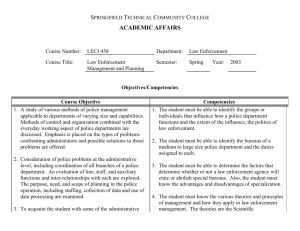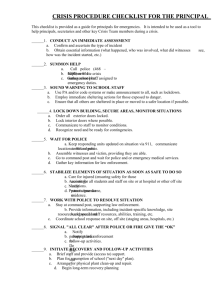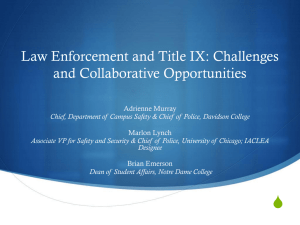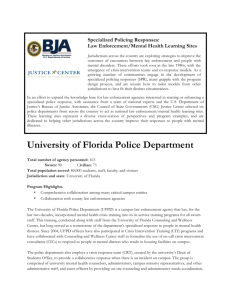Best Practice Management
advertisement
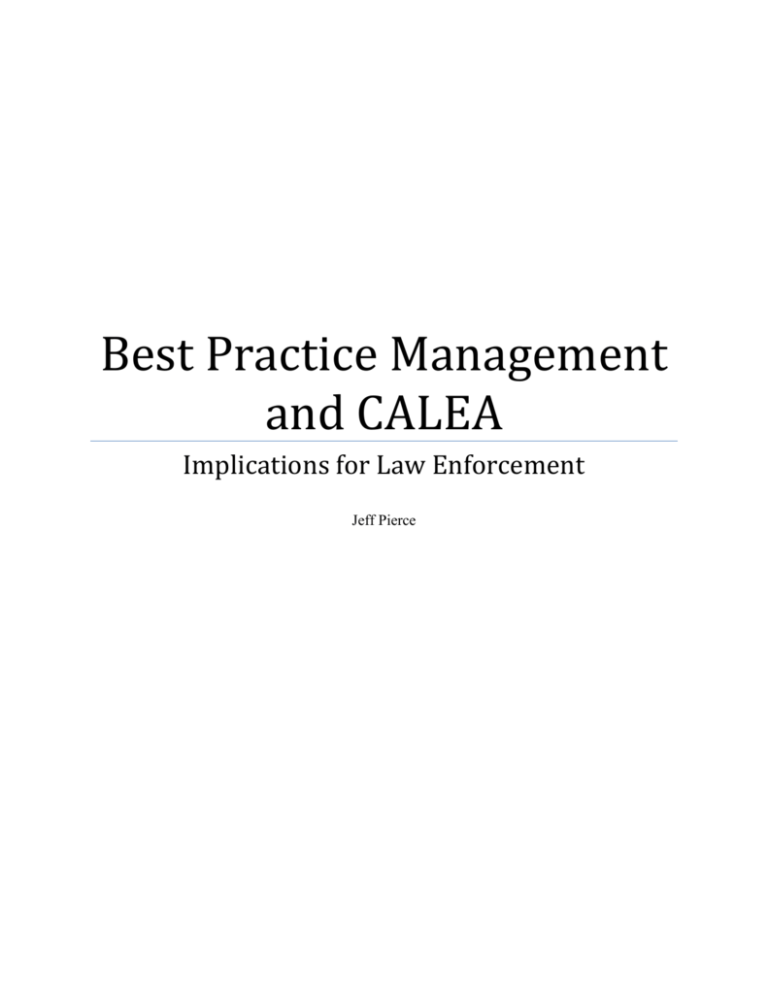
Best Practice Management and CALEA Implications for Law Enforcement Jeff Pierce Abstract During the decade of the 1960‟s, academia began to think about and discuss a need to study and reform law enforcement practices in the United States. In 1965, the Federal Government, in partnership with academic professionals in a variety of disciplines, formed the Presidents Commission on Law Enforcement and Administration of Justice, also known as The President‟s Crime Commission. Over time, the work of this body resulted in an official stance in recognizing the need to promote academic research into crime, it‟s control and how it effects society (Walker, 1992, p.21). In addition, the commission discovered environmental factors impacting law enforcement operations (Walker, 2007, p.3). These included; Law enforcement procedures affected by Supreme Court decisions. Allegations of discriminatory police practices by the civil rights movement. Social disorder and civil unrest resulting in riots in several major cities during the early and mid 1960‟s. Sharp increases in overall reported crime in major metropolitan cities. Significant increases in drug use by the nation‟s youth attributed to the counter culture movement. Increased open hostility and defiant acts towards law enforcement by the countries youth. Recognition and further discussion of these issues supported the organized development 2 and eventual limited implementation of nationwide models of “Best Practice” management for law enforcement functions in the late 1970‟s. The concept, as it now applies to law enforcement in the United States was developed in conjunction with academia. Although, to this day, significant strides in this endeavor have occurred, overall, US law enforcement agencies appear to have been slow to embrace the principles of best practice management. Despite this, it is clear police agencies operating under a system of best practices, prove in the long run to be not only be more operationally efficient, but also provides the public with the best value for the dollars invested by minimizing the costs of civil liability as well as providing a standardized blueprint for a sound system of functioning policies and procedures backed by research. 3 Introduction The Information Age has served as the catalyst for dramatic leaps in a many areas of our present day society. Law enforcement is no exception. Police agencies throughout the nation have benefited too, in the way of access to information concerning court decisions, as well as the internet providing a virtual library for „lessons learned‟ which impact law enforcement procedures on a continual, if not almost daily basis. Information access and dissemination also continues to challenge police agencies to speed up their response actions to information, most often experienced in the form of continual evolutionary adjustments to operational directives and procedures. The continual evolutionary cycle is not only necessary, but is in many instances mandated to ensure compliance with court decisions regarding the legality in certain aspects of police operations. It is well known by working professionals within the field of criminal justice, in the last three decades U.S. law enforcement in total has witnessed the far reaching impact of many precedent setting procedural criminal court decisions. Examples of these decisions are well known within the circle of working law enforcement professionals by simple names like; Miranda, Garrity, Brady, Giglio and Garner, to name only a few. However, the impact these and other high court decisions like them have had on police practices and operations is not as simple. These particular decisions, and others like them , have forced law enforcement agencies at all governmental levels to change the way they do business at the operational level. One significant reason why, is the growing number of 4 specialized legal professionals targeting the deep pockets of government in which they often view as a means to an easy payday. Another reason is better informed citizens, demanding professionalism from the law enforcement agencies which serve them. Police malpractice litigation has grown in the last thirty years at a pace never before experienced by U.S. law enforcement agencies in the entire history of the profession. To show the enormity of this issue, in just the decade from 1976 to 1986 alone, pursued civil litigation against police agencies rose an unbelievable 517% (Stafford, P.30). As a result of, and in a seemingly logical response to this issue, it is prudent for law enforcement agencies of every size to exercise due diligence in the evolution of their business practices. The most effective way to accomplish this is by utilizing partnerships with both academia and professional management organizations, such as CALEA which is founded on and committed to the enhancement of “Best Practice” models in law enforcement. Police Best Practices Explained Best Practices in police management is a term interchangeable with what is often described within other academic disciplines as Evidence based Policy making. The conceptual idea behind both holds that public policies are effective where there is evidence from scientifically sound research studies determining their probability for effectiveness (University of Maryland, 1997). At first glance, one may question the significance of best practice as it relates to law enforcement. What is its significance? Why is it needed? One excellent explanation has been 5 expressed by Dr. Malcolm Sparrow, of Harvard University‟s, John F Kennedy School of Government. Sparrow, is well known within academia social disciplines for his extensive research into the mechanics of governmental regulatory and police agencies. He describes law enforcement as more than merely an entity providing a public “service”. Instead, its real purpose is the fulfillment of “obligations” to society through the mitigation of identified risks.” According to Dr. Sparrow‟s research, the fundamental purpose of any regulatory agency, which includes law enforcement, is simply to “pick important problems, and fix them” (Sparrow, 2000). This concept goes far beyond the general public perception of the basic duty of police to merely “respond” to 911 calls for service in reference to some immediate, real or perceived issue. How these problems are fixed and the controls or guidelines used to fix them become no less important after initial identification. The significance here is that CALEA‟s best practice management principles go hand and hand with Sparrows ideas of regulatory reform which he argues, provides law enforcement agencies of all locations, sizes and configurations, a research driven standardized platform in which to carry out its obligations to society. Why is Management by Best Practice good for Law Enforcement ? In a paper submitted to the National Institute of Justice in 2006 titled, Police Accountability-Current Issues and Research Needs, Dr. Samuel Walker, Emeritus Professor of Criminal Justice at the University of Nebraska-Omaha, addressed this question. In his paper Dr. Walker acknowledged three areas, he believes have led to a recent increased interest in overall subject of police accountability. Outlined below, the areas identified by Walker are; 6 1. “Section 14141 of the 1994 Violent Crime Control Act, which authorizes the U. S. Justice Department to bring suit against law enforcement agencies where there is a “pattern or practice” of abuse of citizens’ rights and to seek organizational reforms designed to end those abuses.” (Walker, 2006) Additionally, it is interesting to note, from 1997 through 2008 the Civil Rights Division of the Justice Department has reached settlements by imposing either legal consent decrees or other legally binding memoranda of understanding, upon twenty US law enforcement agencies (U.S. Department of Justice, Civil Rights Division). Most of these settlements can be seen to have some parallels of commonality, including requiring subject agencies to adopt best practice policies concerning the use of force, including both deadly and less-lethal force, improve citizen complaint procedures, implementation of an early intervention system and finally, to improve the training related to these areas (US DOJ, Special Litigation Section). 2. “Early intervention systems (EIS), also known as Early Warning Systems, have proven to be an important new management tool designed to enhance individual officer accountability. An EIS system involves a computerized data examination based on an officer’s performance. The data permits analysis by police agency management for the purpose of identifying officers who appear to have recurring performance problems (e.g., high rates of use of force, citizen complaints, etc.). Officers who are identified are then subject formal interventions (typically counseling or retraining) designed to correct the performance problems (Walker, 2006). 7 Since 2004, an agency Early Intervention System has been a mandatory standard, by the Commission on the Accreditation of Law Enforcement Agencies. Agencies must be in compliance with this standard to receive professional accreditation (CALEA, 2008: 35.1.9). 3. “ Civil rights and civil liberties activists have demanded external procedures for reviewing citizen complaints against law enforcement agencies, arguing that review outside the agency is more transparent. The total number of external police oversight agencies in the form of citizen review or citizen advisory boards has grown from one in 1970 to over 100 by 2001 ( Walker 2006). In response to this issue, CALEA has established appropriate best practice model based standards to guide law enforcement agencies in the establishment of appropriate and transparent procedures to assist agencies in investigating all citizen complaints in a timely, fair and consistent manner, for all concerned. CALEA‟s continually evolving standard development in all three of these areas reflects the growing public interest in police accountability. Agency participation in CALEA Accreditation reflects the willingness of a law enforcement agency to progressively review and adopt new management and operational procedures voluntarily, rather than being required as a result of conflict resulting in US Department of Justice Consent Decrees or Memorandums of Understanding. Likewise, agencies‟ who respond with the implementation of voluntary best practice measures appears to be the preferred path of least resistance. Also for consideration, is the individual agency‟s interest in showing the community its willingness to operate openly and provide an avenue to report its accomplishments as well as any potential failings. This is 8 especially important since it‟s the failings, which appear to draw the majority media interest in any jurisdiction in these times. Today, more than ever before, it is clear citizens in every corner of this country are demanding not only police agency accountability in carrying out the day to day obligations and objectives of law enforcement, but also a degree of accountability for individual officers as they pursue their daily duties and special assignments. At present, management by best practice is the only viable way to accomplish the objectives of responsibility and accountability in both instances. International CALEA Accreditation is the proven vehicle for law enforcement agencies to get there. Conclusion The author believes this paper has presented compelling evidence why Law Enforcement Agencies should strongly consider the adoption of a system of established "Best Practices" to lessen the pitfalls of civil liability and fulfill the obligation of providing a benchmarked level of service. As demonstrated, a central fact concerning the reality of the issue at present is, only a small percentage of all law enforcement agencies in this country work within the context of operating under an available established 'best practice' system of management. The overwhelming majority of US police agencies are small, with most having fewer than ten officers and either operate within the broad purview of state law or with minimal policy and procedure and without a mechanism for regular updating outside of compulsory court decisions. The negative results of this manner of operation include maximizing exposure to civil liability, which is an avoidable, risky and oftentimes costly proposition for taxpayers. In the end game, it truly is a plan and pay now, to avoid paying more, later proposition. 9 The reasons best practice management in law enforcement has been slow to catch on vary, but a central underlying theme appears generally as governmental oversight officials failing to identify dedicated funding to commit to the endeavor. This appears especially true for smaller agencies ability to participate in established accreditation programs. It appears these same decision makers fail to either see or care that best practice management is really the bridge to professional law enforcement in the new millennium. The most progressive state and local law enforcement agencies have already undertaken the challenge and utilize an academically based “best practices” management systems available through existing professional accreditation organizations. The remainder should strongly consider doing so. Ignoring this very important concept in police management exposes departments and cities to certain measurable and avoidable financial risks. The best practice management approach minimizes agency civil liability while at the same time maximizes efficiency and the overall public value of police departments. After all, Risk Management itself is a best practice. However, in the end the most important benefit may be that best practice management may very well serve as the ladder firmly and finally elevating law enforcement from the level of an occupation to that of an officially recognized profession. 10 References: American Society of Crime Laboratory Directors (ASCLD), http://www.ascld.org. Retrieved; November 31, 2009. American Bar Association. http://www.abanet.org/marketresearch/2004nbroflawyersbystate.pdf. Retrieved; October 15, 2009. (A) Crime Lab Report: Hundreds of Cases Mishandled, Click2Houston.com. http://www.click2houston.com/news/13493311/detail.html, June 13, 2007. Retrieved; November 3, 2009. US Bureau of Justice Statistics. http://www.ojp.usdoj.gov/bjs/lawenf.htm. Retrieved; October 15, 2009 (A) Centre for Evidence-based Medicine. http://www.cebm.net. Retrieved; October 20, 2009. Coalition for Evidence Based Policy. http://www.evidencebasedprograms.org. Retrieved; October 20, 2009. Commission on Accreditation for Law Enforcement Agencies: Standards Manual 2008. (5th ed.) Fairfax: CALEA (A) Commission on Accreditation for Law Enforcement Agencies (CALEA). http://www.calea.org/agcysearch/agencysearch.cfm. Accessed; November 18, 2009. Consumer Reports Online, Stop Thieves from Stealing from You: October, 2003. http://www.consumerreports.org/cro/money/credit-loan/identity. Retrieved; October 11, 2009. Committee on Law and Justice. Improving Evaluation of Anticrime Programs, 2005. Washington, DC: National Academy Press. http://books.nap.edu/openbook. Retrieved; October 20, 2009. (A) Federal Bureau of Investigation, Cyber Investigations Portal: http://www.fbi.gov/cyberinvest/cyberhome.htm. Retrieved; October 11, 2009 (A) International Association of Campus Law Enforcement Administrators. http://www.iaclea.org/visitors/profess http://www.iaclea.org/visitors/professionaldevelopment/accreditation/accreditationagencies.cfmionaldevelopment/accreditation/a ccreditationagencies.cfm. Accessed; November 18, 2009. Moore, M (2002). Recognizing Value in Policing. Washington DC: Police Executive Research Forum. (A) National Criminal Justice Reference Service, Police Departments, 2000: http://www.ncjrs.gov/App/publications/Abstract.aspx?id=196002. Accessed; November 12, 2009. (A) “Police Shutter Print Unit: Identification Error, Critical Report Cited,” Boston Globe, October 14, 2004, http://www.boston.com/news/local/massachusetts/articles/2004/10/14/police_shutter_print_unit/. Retrieved; November 3, 2009. Privacy Rights Clearinghouse: A Chronology of Data Breaches, September, 2007. http://www.privacyrights.org/ar/ChronDataBreaches.htm. Accessed; October 1, 2009. Stafford, A. (1986) Lawsuits Against Police: Journal of Police and Criminal Psychology, March 1986. (A) Sparrow, M. (2000) The Regulatory Craft: Controlling Risks, Solving Problems and Managing Compliance. Washington, DC: Brookings Institute Press (A) University of Maryland (1997) Preventing Crime: What Works, What Doesn’t, What’s Promising, Washington,DC: Department of Justice. (A) 11 US Department of Justice, Civil Rights Division: http://www.justice.gov/crt/split/findsettle.php#congrep. Accessed; October 20, 2009. (A) US Department of Justice, Special Litigation Section: http://www.justice.gov/crt/split/overview.php. Accessed; October 20, 2009. (A) Walker, S. (1992). The Police in America: An introduction. (2nd ed.) New York: McGraw-Hill. (A) Walker, S. (2007) Police Accountability: Current Issues and Research Needs, Washington DC: National Institute of Justice. (A) 12

